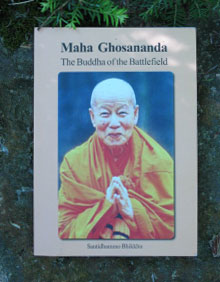

Review:
“Maha Ghosananda: The Buddha of the Battlefield”
“Maha Ghosananda: The Buddha of the Battlefield” is an account of the Cambodian monk who many Cambodians revere as a saint or bodhisattva. It was written by Ven. Santidhammo, an American Theravadan Monk who lives at Wat Atammayatarama in Woodinville, Washington. Santidhammo has had a long-term connection to Cambodia. During his early years as a Buddhist in Seattle, he was involved in the local Cambodian community and learned about Maha Ghosananda. Later, when he lived and studied in Cambodia from 1998 to 1999, he had the opportunity to meet him.
Although he is not as well known as some other Buddhist leaders, Maha Ghosananda accomplished a great deal during a remarkable lifetime. His story weaves together several threads: the history of modern Cambodia, the emergence of “engaged Buddhism,” the practice of compassion and tolerance in response to great suffering, and the healing role of the Dharma.
This short book offers a wonderful synopsis of this great man’s life, from his early years as a scholar and monk as he left Cambodia in 1953 to study Pali and Sanskrit in India, to his nine years in meditation retreat in Thailand from 1968 to 1977. He emerged as the spiritual leader of the refugee Cambodian community as they streamed out of Cambodia escaping the devastation of the Khmer Rouge from 1978 on.
In his later years, Maha Ghosananda spent time both in Cambodia and the West. He was very involved with the Peace Walk movement of the Nipponzan-Myohoji founded by Nichidatsu Fuji and founded his temple in the U.S. next to the organization’s Peace Pagoda in Massachusetts. He was nominated for the Nobel Peace Prize, conducted many dhammayietra (peace walks) throughout Cambodia—even in the midst of war—and spoke about the need to “leave our temples and enter the temples of ...suffering...the refugee camps, the prisons, the ghettos, and the battlefields...”
Reflecting on the book, Santidhammo comments, “One time he said to me: ‘if you can’t find happiness in the face of difficulties, what good is spiritual practice? Be happy, even in the face of genocide, in the face of famine, in the face of the AIDS epidemic. You have to be happy because this is the gift that we can give to people, it is an act of compassion not to be overcome.’ This is especially remarkable given the fact that Maha Ghosananda’s family had been exterminated by the Khmer Rouge who had also killed most of the Cambodian monastic sangha. Only about 3,000 monks survived out of 60,000. Maha Ghosananda worked for reconciliation of all the factions throughout the time of his activism.”
Santidhammo tells a story of his first meeting with Maha Ghosanada here in the States: “He was so low-key. We were gathered there, and didn’t know what to expect...a dhamma talk or something...and what he did was to pass around ice cream bars. So all the monks sat around outside eating ice cream bars and just smiling and being happy...this was his teaching...to enjoy together...to enjoy happiness together.”
“Maha Ghosananda: The Buddha of the Battlefield,” is being distributed free of charge, but donations will help defray the costs of publication and be used to continue his work.
To order “Maha Ghosananda: The Buddha of the Battlefield,” contact Santidhammo (Ajahn Tom) at Wat Attamma, (425) 481-6640 or at teflint@yahoo.com.
Make a contribution via check or money order to:
Ghosananda Project c/o Wat Attamma
19301 176th Ave NE
Woodinville, WA 98072
Contributor: Timothy O'Brien.
Photo: Amy Groncznack.